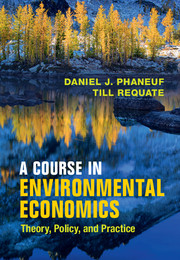Book contents
- Frontmatter
- Dedication
- Contents
- Figures
- Tables
- Preface
- Notational Conventions
- PART I ECONOMICS AND THE ENVIRONMENT
- PART II THE DESIGN OF ENVIRONMENTAL POLICY
- 4 Imperfect Information
- 5 Competitive Output Markets
- 6 Non- Competitive Output Markets
- 7 Environmental Policy with Pre- existing Distortions
- 8 Institutional Topics in Cap and Trade Programs
- 9 Ambient Pollution Control
- 10 Liability
- 11 Innovation and Adoption of New Technology
- 12 International Environmental Problems
- 13 Accumulating Pollutants
- PART III VALUING THE ENVIRONMENT
- PART IV THE PRACTICE OF ENVIRONMENTAL ECONOMICS
- References
- Author Index
- Subject Index
13 - Accumulating Pollutants
from PART II - THE DESIGN OF ENVIRONMENTAL POLICY
Published online by Cambridge University Press: 27 February 2023
- Frontmatter
- Dedication
- Contents
- Figures
- Tables
- Preface
- Notational Conventions
- PART I ECONOMICS AND THE ENVIRONMENT
- PART II THE DESIGN OF ENVIRONMENTAL POLICY
- 4 Imperfect Information
- 5 Competitive Output Markets
- 6 Non- Competitive Output Markets
- 7 Environmental Policy with Pre- existing Distortions
- 8 Institutional Topics in Cap and Trade Programs
- 9 Ambient Pollution Control
- 10 Liability
- 11 Innovation and Adoption of New Technology
- 12 International Environmental Problems
- 13 Accumulating Pollutants
- PART III VALUING THE ENVIRONMENT
- PART IV THE PRACTICE OF ENVIRONMENTAL ECONOMICS
- References
- Author Index
- Subject Index
Summary
In the previous chapters we studied pollution problems mainly in a static framework. With noise pollution, for example, the externality results directly from the instantaneous flow of noise. Many other pollutants, however, accumulate, and the externality results from the stock of the pollutant rather than from its flow. This is in particular the case for greenhouse gasses such as carbon dioxide. It is also relevant for air pollutants such as sulfur dioxide and nitrogen oxides, as well as for liquid pollutants that accumulate in groundwater reservoirs. This is not to say that our analysis so far is valid only for noise or other non-accumulating externalities, in that we can interpret our earlier findings as steady-state results. In this chapter, however, we focus directly on the dynamic consequences of accumulating pollutants. Although we do not deal in depth with resource economics in this book, pollution abatement for accumulating pollutants has parallels to the exploitation and management of renewable resources. In the case of climate change, for example, the atmosphere can be thought of as a sink for pollutants, and as such as a renewable resource.
To analyze accumulation dynamics, we need additional analytical tools from dynamic systems analysis. When conducting analysis in continuous time, we typically apply methods from dynamic optimization and optimal control. A full introduction to optimal control theory is beyond the scope of this book. Nonetheless, in appendix A to this chapter we briefly define the main concepts of optimal control theory, and lay out in a recipe-like fashion the corresponding optimality conditions.
This chapter is organized as follows. In section 13.1 we set up a dynamic version of our Chapter 3 model, with environmental damage resulting from accumulated pollution. We start by briefly presenting a discrete time version of the model to derive the optimality conditions via the familiar Lagrange method. In section 13.2 we then analyze the continuous time model in detail by first setting up the optimality conditions and looking at the optimal steady state, and then turning attention to the optimal path into the steady state. We do this analytically and using phase diagram analysis. In section 13.3 we link the problem of an exhaustible resource to the problem of an accumulating pollutant.
- Type
- Chapter
- Information
- A Course in Environmental EconomicsTheory, Policy, and Practice, pp. 353 - 388Publisher: Cambridge University PressPrint publication year: 2016



